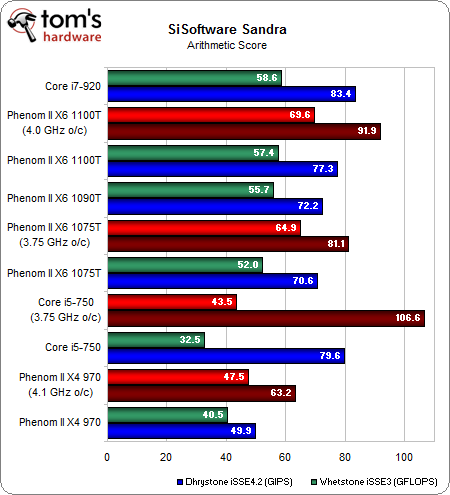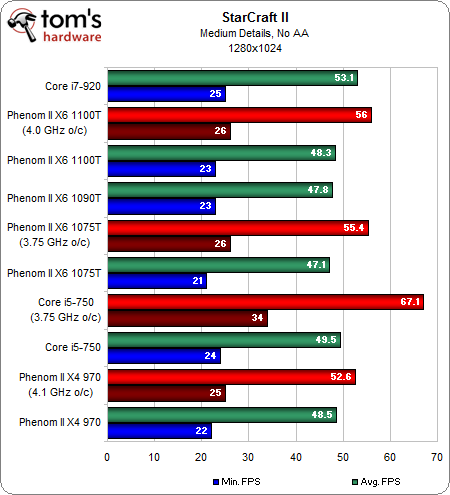AMD Phenom II X6 1100T Review: The New Six-Core Flagship
Overclocking
We’re always interested to see if new processors might be better overclocking candidates than the older versions, and to that end we’re pushing the Phenom II X6 1100T to the limit. Unfortunately the result isn’t especially encouraging, with a 4 GHz final result using a 20x CPU multiplier combined with BIOS settings of 1.5 V for the CPU and 1.4 V for the CPU northbridge. The memory managed to hold at 536 MHz with low 7-7-7-16-27 timings.
This is the same CPU overclock we achieved with our Phenom II X6 1090T in a previous overclocking article, so while it's a respectable result for a Phenom II X6, we’re not particularly impressed with the potential of our new sample. Here are the test results:
The overclocked Phenom II X6 1100T manages to push its way past the stock Core i7-920 here, but the overclocked 3.75 GHz Core i5-750 pulls a much higher Dhrystone result and shows why Intel is such a formidable opponent in the overclocking arena (gotta respect the manufacturing technology advantage there). Nevertheless, the overclocked Phenom II X6 1100T manages to achieve a much higher Whetstone score than the overclocked Core i5-750.
The DivX codec shows a large performance increase with the Phenom II X6’s hexa-core architecture, but the Xvid codec prefers raw speed and Intel’s processor architecture. The overclocked Phenom II X6 1100T beats all of the stock processors here, but the overclocked Core i5-750 scores a clear win when it comes to Xvid encoding. Note that the overclocked 3.75 GHz Phenom II X6 1075T performs just as fast as the 4.0 GHz Phenom II X6 1100T in this test, probably because of the 1075T's overclocked 250 MHz bus speed compared to the 1100T's standard 200 MHz bus.
As we said previously, our StarCraft 2 benchmark is CPU-limited. The game does respond very well to Intel Core i5 overclocking, but the Phenom II CPUs don’t show much of a performance increase when pushed to 4 GHz.
Get Tom's Hardware's best news and in-depth reviews, straight to your inbox.
Don Woligroski was a former senior hardware editor for Tom's Hardware. He has covered a wide range of PC hardware topics, including CPUs, GPUs, system building, and emerging technologies.
-
Mark Heath I wish Intel would do something like this for all (or at least most) of their processors.(the speed bumps with same price model)Reply -
fstrthnu A pretty good effort from AMD, but Sandy Bridge is only 2 or 3 months away by now. Of course, this is just a stopgap measure till Bulldozer comes; still, when AMD is only just catching up to Intel in terms of stock performance NOW (even though it has slightly better value)...Reply -
sideshowbob32 Great article I just ordered a 1090T for m old am2+ set up, I look forward to it and this article makes me want it more!! Glad to see amd is doing great.Reply -
stingstang AMD is most certainly not doing great if they have to rerelease all their chips. Here's what happens: They make a batch of chips and sell them all as 4 core processors at X speed. The ones they don't sell or are returned go into stress testing. Those batches are divided in to x2 or x3 piles depending on how stable they are with which cores enabled. The winners of the tests get promoted and branded as new, faster chips with x+100 MHz. The process then repeats.Reply
Now if you'll look, their third iteration of this process still doesn't match intel's entry-level i7 processors. It's just embarrassing is what that is. -
Could this be any more unremarkable or unnecessary a product? Might as well grab an i5, or one of the existing X6s, or wait for SB, or Bulldozer... this is just pointless.Reply
-
buzznut I'm waiting as well I think. I'd have to upgrade my mobo to run a X6 anyway since Biostar chose not to support it with my current board. I think the 1090T is a great value at $230 though. Pretty sweet.Reply -
sudeshc thats more like it, increase those stock speeds and the we will have more chance to to get even more performance by overclocking :DReply -
FunSurfer It would be nice to see in the gaming benchmark games that have intensive use of all the CPU's cores like GTA4, BFBC2, RFG (@ large building destruction).Reply -
dEAne With this data Sandy Bridge will not put pressure on AMD it will kill it. I think the only thing left for AMD is to lower the price much further.Reply


